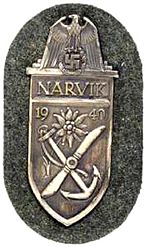Narvik Shield
| Narvik Shield Narvikschild | |
|---|---|
 Narvik Shield in silver designed by Professor Dr Richard Klein | |
| Type | Badge |
| Eligibility | Military personnel |
| Campaign(s) | World War II |
| Status | Obsolete |
| Established | 19 August 1940 |
The Narvik Shield (German: Narvikschild) was a World War II German military decoration awarded to all German forces that took part in the battles of Narvik between 9 April and 8 June 1940. It was instituted on 19 August 1940 by Adolf Hitler. The Oberkommando der Wehrmacht (OKW) published the order the same day. A total of 8,577 military personnel received the award. It was bestowed by General Eduard Dietl, the commander of Army Group Narvik.[1][2]
Design
Designed by Professor Dr Richard Klein of Munich, the narrow shield features a pointed bottom and, at its apex, an eagle with down-swept wings clutching a laurel wreath that surrounds a swastika. Below this in capital letters is written NARVIK. The body of the shield features an edelweiss (representing the Heer mountain troops), an anchor (representing the Kriegsmarine), and propeller (for the Luftwaffe). The anchor and propeller are crossed, with the edelweiss placed at the top of the X. The numbers 19 and 40 appear at the top corners of the main body of the shield.[3][2]
The shield was hollow backed and stamped from sheet metal which was usually zinc. It was worn on the upper left arm of the uniform. The shield was awarded in two versions; silver-gray versions for army and Luftwaffe and a gilded (golden coloured) version for Kriegsmarine.[3]
Narvik Shield 1957
In 1957, the Narvik Shield, along with many other German military decorations of World War II, was reauthorized for wear by qualifying veterans. The new version was without the eagle and swastika symbol of the Third Reich.[citation needed]
See also
Notes
- ^ a b Angolia 1987, p. 276.
- ^ a b Ailsby 1987, p. 96.
- ^ a b Angolia 1987, pp. 277.
References
- Ailsby, Christopher (1987). Combat Medals of the Third Reich. Harpercollins. ISBN 978-0850598223.
{{cite book}}: Invalid|ref=harv(help) - Angolia, John (1987). For Führer and Fatherland: Military Awards of the Third Reich. R. James Bender Publishing. ISBN 0912138149.
{{cite book}}: Invalid|ref=harv(help)
